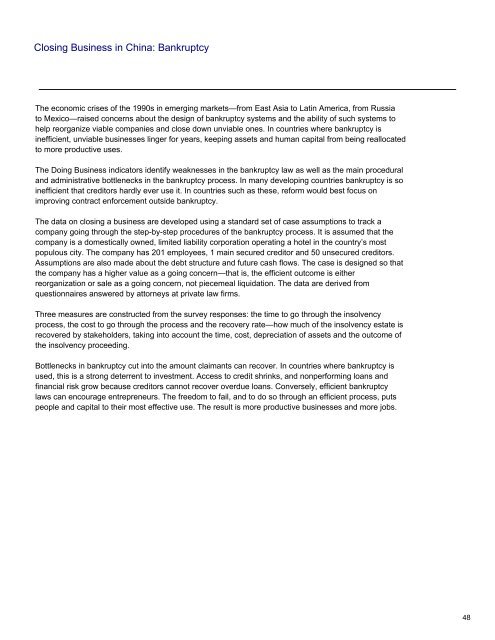View full report - NEEC
View full report - NEEC
View full report - NEEC
- No tags were found...
You also want an ePaper? Increase the reach of your titles
YUMPU automatically turns print PDFs into web optimized ePapers that Google loves.
Closing Business in China: BankruptcyThe economic crises of the 1990s in emerging markets—from East Asia to Latin America, from Russiato Mexico—raised concerns about the design of bankruptcy systems and the ability of such systems tohelp reorganize viable companies and close down unviable ones. In countries where bankruptcy isinefficient, unviable businesses linger for years, keeping assets and human capital from being reallocatedto more productive uses.The Doing Business indicators identify weaknesses in the bankruptcy law as well as the main proceduraland administrative bottlenecks in the bankruptcy process. In many developing countries bankruptcy is soinefficient that creditors hardly ever use it. In countries such as these, reform would best focus onimproving contract enforcement outside bankruptcy.The data on closing a business are developed using a standard set of case assumptions to track acompany going through the step-by-step procedures of the bankruptcy process. It is assumed that thecompany is a domestically owned, limited liability corporation operating a hotel in the country’s mostpopulous city. The company has 201 employees, 1 main secured creditor and 50 unsecured creditors.Assumptions are also made about the debt structure and future cash flows. The case is designed so thatthe company has a higher value as a going concern—that is, the efficient outcome is eitherreorganization or sale as a going concern, not piecemeal liquidation. The data are derived fromquestionnaires answered by attorneys at private law firms.Three measures are constructed from the survey responses: the time to go through the insolvencyprocess, the cost to go through the process and the recovery rate—how much of the insolvency estate isrecovered by stakeholders, taking into account the time, cost, depreciation of assets and the outcome ofthe insolvency proceeding.Bottlenecks in bankruptcy cut into the amount claimants can recover. In countries where bankruptcy isused, this is a strong deterrent to investment. Access to credit shrinks, and nonperforming loans andfinancial risk grow because creditors cannot recover overdue loans. Conversely, efficient bankruptcylaws can encourage entrepreneurs. The freedom to fail, and to do so through an efficient process, putspeople and capital to their most effective use. The result is more productive businesses and more jobs.48











